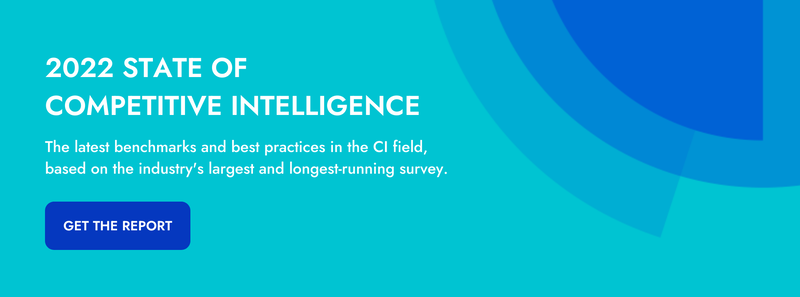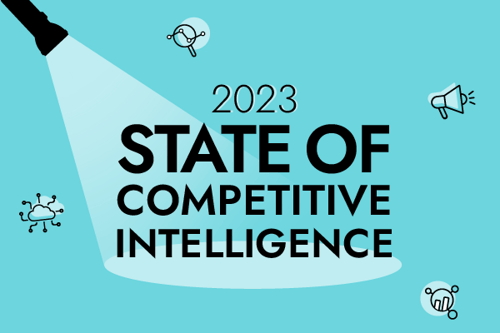While your company may have a strong grasp of what’s happening internally, understanding what’s happening externally in your marketplace is critical for sound decision-making. This is where competitive intelligence (CI) comes into play–the process of capturing and analyzing information about your rivals to drive internal strategy changes and tactics.
Before we dive into specific sources of competitive intelligence that your company should explore, let’s paint the picture of how companies view CI. According to our 2021 State of CI Report, 70% of businesses have CI teams with 2+ dedicated professionals, and 92% of CI stakeholders believe CI is important to overall company success.
Get the latest data. Download the 2022 State of CI Report >>
If you're convinced, here are eight sources of competitive intelligence you can start exploring today to set your company up to win:
- Your competitors’ websites
- Social media
- Your customers
- Your competitors’ customers
- Your competitors’ employees
- Your colleagues
- Earned media
- Your competitors’ content channels
Let’s dig in!
8 sources of competitive intelligence
1. Your competitors' websites
Unsurprisingly, your competitors’ websites are a robust resource when it comes to gathering CI. If you want to better understand your rivals’ priorities, targets, and overall direction this is a great starting point. These sites can reveal: (1) Product or feature upgrades, (2) new job openings or hires, (3) messaging and positioning modifications, (4) marketing initiatives (i.e. a webinar or event), (4) pricing, (5) news announcements, and more.
Let’s say you want to explore the website of SalesForFree (this is a made-up company):
First, check out their homepage. What are they spotlighting? Has their company slogan changed? Do they have any customers or testimonials listed? What message are they pushing to readers? This page will reveal what they are prioritizing and finding to be most important to share with prospects and customers at this time.
Next, scroll over to the SalesForFree product page to evaluate the company’s entire scope of services. Analyze the product features and benefits, pricing, videos, and any imagery or screenshots. You’ll learn what audience they’re targeting, how your technology stacks up, and the pain point(s) they believe their product addresses.
Get the point? Good! This is the type of all-compassing intel that can help you stay one step ahead.
2. Social media
An important source of competitive intelligence–that, I must add, often doesn’t come to mind for some–is social media. Seeing firsthand what companies are discussing and sharing publicly is a great way to gain intel into priorities, product initiatives, marketing campaigns, and more.
Most companies utilize LinkedIn, Facebook, Twitter, and Instagram. Dive into the type of content that they’re posting and who they’re interacting with on social media. You can even go as far as to analyze who and what they’re following–and who is following them!
For example, did a prospect you’ve been talking to recently follow them? If that’s the case, they’re likely speaking with them as well, evaluating both solutions. Or, perhaps your rival shared that they hired a new Head of Engineering? This would tell you that they’re growing and making some serious pivots in their company’s direction.
Let’s take a closer look at the specific types of intel you can gather from the top platforms amongst B2B companies–LinkedIn and Twitter.
Did you know that over 55 million companies are registered on LinkedIn?
This platform is a treasure trove for competitive knowledge-building. You can see exactly what your competitors are focusing their efforts on and putting out into the digital world–and chances are they’re using it regularly. While analyzing the content of the written posts can prove to be fruitful, LinkedIn also allows you to explore a full list of employees, events they’re putting on, “Life Pages” (which showcase company culture), and more.
Here’s an example for you: Imagine you are scanning a competitor’s LinkedIn page and see a new case study promoted. They are spotlighting an old customer of yours–one that was unsatisfied with your company’s security measures for data storage. While disappointing, this likely means that their product security measures are superior to yours–it’s time to revamp security at your company to remain competitive!
Similar to LinkedIn, Twitter is a very strong source of competitive intelligence. To put it in perspective, 67% of all B2B businesses are using Twitter as a digital marketing tool. Twitter differs from LinkedIn in its more conversational and casual approach, and companies tend to communicate more freely with customers through quote retweets, replies, and threads. Some companies even use it as a customer service tool.
Let’s look at this conversation on Twitter from Evernote as an example.
We’ve pinpointed a pain point here for Evernote customers… integration capabilities. While this could be a one-off case, upon more digging you may find that it is actually a huge problem for customers and prospects. That user even specifically noted that this is the reason she won’t subscribe to them. If you were a competitor, this would be the perfect opportunity to arm your sales reps with this knowledge. While at a glance it may look minute, there’s no doubt that this intel could be used to your advantage if you’re a direct competitor.
3. Your customers
Another great source of CI that is a more obvious approach is connecting with your customers and prospects directly. Chances are they scoured the market before landing on your offering. They’ll have great insight on reputations and strengths and weaknesses for not only your offering but your rivals as well. They’ll know exactly what pain points your target audience has and what offerings work (and don’t) in the marketplace to meet those needs.
Of course, you can connect with them directly, but we understand that can be a time-consuming approach. Some more efficient approaches include conducting surveys using SurveyMonkey, Doodle, Google Forms, etc., or hosting discussion groups to learn more about their perspectives on your marketplace and brand. Or, you can even be a fly on the wall during a sales and/or customer success meeting. Whichever method you choose, you’ll gain incredible intel to bring back to your team.
4. Your competitors' customers
There are a plethora of free online platforms and resources that can provide you with deep insights into how your company stacks up against its alternatives. One of the most useful resources of all is reviews and discussion threads, allowing you to gain perspective on what your competitors’ customers really think.
Review sites
There’s no sugar coating on review sites. Reviews tend to be concise, to the point, and blatantly honest. For some, it’s easier to express perspectives online vs. in person or on the phone; it’s always smart to read through not only your own company’s reviews but other market leaders’ customer reviews as well.
Below is a list of some sites to explore reviews, and keep in mind that these review sites are geared towards B2B companies.
- G2 Crowd
- TrustPilot
- TrustRadius
- Capterra
- SoftwareAdvice
- CompareCamp
As an example, let’s analyze a review on G2 Crowd about Crayon.
Right from the start, the customer review addresses a pain point–being able to effectively discuss market alternatives. The salesperson’s review touches on how the Crayon platform achieves that for them and is a “one-stop-shop” for competitive analysis. They added that they appreciate the platform's “ease of use” and streamlining capabilities. Now, that’s some powerful insight just from one review, touching upon benefits and common market needs.
Reddit and Quora
Other sources of competitive intelligence that are free and at your fingertips are Reddit and Quora! To put it in perspective, Reddit has 430 million monthly active users and over 100,000 active communities, and Quora is ranked in the top 400 most popular websites worldwide. These sites are home to endless threads of market questions, concerns, and competitor comparisons. It’s a chance to see what your rivals’ customers are talking about and valuing most about their offering.
You can also use these platforms as an anonymous way to ask any questions that you need further information on. For example, let’s say you recently asked your customers “Which market leader has the strongest UX design?” and they all have different opinions. This is a way to get more answers to better solidify your CI research, connecting with your competitors’ customers directly who are well-versed in the industry.
5. Your competitors' employees
You may be surprised by the amount of competitive intelligence you can gather from your competitors’ employees. I’m sure we can all agree that for any company, the core of its success is because of its employees. Employees know the ins and outs and strengths and weaknesses on a level no competitor will ever fully understand. Some key spots to find these reviews are:
- Glassdoor
- Indeed
- Comparably
- CareerBuilder
So, what types of intel can you collect?
First off, you can gain an understanding of how the company is doing overall. Are employees discussing how there are a lot of turnovers? If employees at a competitor are always changing, that’s not a good sign. That means they are putting most of their efforts and resources towards training and onboarding, directing focus away from improving the product, website, etc.
Do employees discuss higher-ups’ success in leading? Or, did any employees share their salary? It could be fruitful to explore the level of seniority required and pay for the same role at your company versus theirs. For example, do you require 10+ years for a director role and they only require five? That could provide you with insight into the level of expertise leaders have in not only their roles but the industry as a whole. You may be leaps and bounds ahead of them and didn’t even realize it.
6. Your colleagues
If your landscape is competitive, you know that your colleagues are in tune with the activities and initiatives of your top rivals. It’s important to check in with all different departments at your company to see if they have any new insights to share with you.
- Your sales team can share common competitive objections, how competitors are talking about your company, etc.
- Your customer success team can share nuggets of intel they’ve gathered from conversations with customers, common reasons customers churned, etc.
- Your product team can share competitor product updates, key differentiators between product offerings, etc.
- Your marketing team can share what types of content your rivals prioritize, what vertical-focused events they’re participating in, etc.
Each function at your company likely has notes on all of these conversations and updates. For example, ask to review a sales rep’s notes from a meeting with a key prospect or take a look at the notes added into your company’s CRM. Also, if you have a structured CI department at your company, chances are you have a Slack channel or platform dedicated to centralizing these types of insights. This is the perfect resource for you to utilize, exploring each insight and pulling key takeaways from them as you go through each finding.
7. Earned media
An additional source of competitive intelligence that is vital is earned media. Analyzing your competitor’s news and public relations activities will show you all the movements going on within their company and product. These activities showcase your rivals’ recent developments and what functions at their company they’re working to evolve.
For example, when a new product is launched, companies almost always share a press release about it. It will discuss why they did it, what it is, its benefits, and more. Or, if a new feature is added to an existing product, companies will write about its benefits and want to discuss it further in media interviews. You can get information about their developments right from the source itself.
8. Your competitors' content channels
Lastly, similar to social media, your competitor’s content channels are filled with valuable insights that can give you direction on the verticals they’re focusing on, topics they’re pushing out, and areas they’re working to further develop thought-leadership on. Some worthwhile assets to explore include:
- Blogs
- E-books
- Podcasts
- Videos (YouTube)
- Brochures
- Research reports
- Datasheets
For example, was the last five out of seven blogs focused solely on sales enablement? That’s a telltale sign of priorities. Or, did they just release a video on YouTube that provides screenshots and commentary on their platform’s capabilities? That may end up being a more robust resource than the company’s product page! Maybe they shared a new datasheet that provides you with a high-level introduction to their technology, results, and customers? The opportunities to pull intel from these resources are endless and evolving every single day.
The time to act on this intel to better position your company is... now.
Let Crayon streamline sources of competitive intelligence for you
At the end of the day, pulling insights from sources of competitive intelligence is critical if you want your company to have an all-encompassing view of your market landscape. But, we understand that analyzing all of these sources of CI regularly may feel like a daunting task (and just another thing on your to-do list). Here at Crayon, we streamline this process for you!
Our software-driven competitive intelligence platform allows end-users to capture, analyze, and act on their competitors' every move. Get 10x more data in 10x less time with Crayon’s software automation.
Explore the Crayon platform today!

Seeing is believing! Check out Crayon for yourself.
Take a Product TourRelated Blog Posts
Popular Posts
-
 The 8 Free Market Research Tools and Resources You Need to Know
The 8 Free Market Research Tools and Resources You Need to Know
-
 6 Competitive Advantage Examples From the Real World
6 Competitive Advantage Examples From the Real World
-
 How to Create a Competitive Matrix (Step-by-Step Guide With Examples + Free Templates)
How to Create a Competitive Matrix (Step-by-Step Guide With Examples + Free Templates)
-
 24 Questions to Consider for Your Next SWOT Analysis
24 Questions to Consider for Your Next SWOT Analysis
-
 How to Measure Product Launch Success: 12 KPIs You Should Be Tracking
How to Measure Product Launch Success: 12 KPIs You Should Be Tracking



